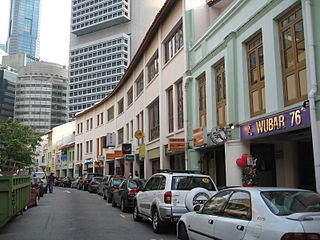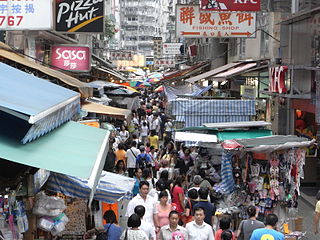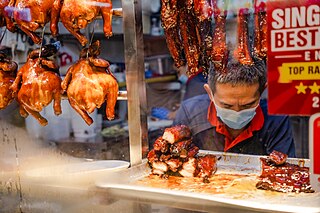
Nasi lemak is a dish originating in Malay cuisine that consists of fragrant rice cooked in coconut milk and pandan leaf. It is commonly found in Malaysia, where it is considered the national dish. It is also a native dish in neighbouring areas with significant ethnic Malay populations such as Singapore and Southern Thailand. In Indonesia, it can be found in several parts of Sumatra, especially the Malay regions of Riau, Riau Islands and Medan. It is considered an essential dish for a typical Malay-style breakfast. Nasi lemak is featured as a national dish in Malaysian tourism brochures and promotional materials.

Hokkien mee, literally "Fujian noodles", is a series of related Southeast Asian dishes that have their origins in the cuisine of China's Fujian (Hokkien) province.

A shophouse is a building type serving both as a residence and a commercial business. It is defined in the dictionary as a building type found in Southeast Asia that is "a shop opening on to the pavement and also used as the owner's residence", and became a commonly used term since the 1950s. Variations of the shophouse may also be found in other parts of Asia; in Southern China, Hong Kong, and Macau, it is found in a building type known as Tong lau, and in towns and cities in Sri Lanka. They stand in a terraced house configuration, often fronted with arcades or colonnades, which present a unique townscape in Southeast Asia, Sri Lanka, and South China.

Petaling Street is a Chinatown located in Kuala Lumpur, Malaysia. The whole vicinity is also known as Chinatown KL. Haggling is a common sight here and the place is usually crowded with locals as well as tourists.

Boon Lay is a neighbourhood located in the town of Jurong West in the West Region of Singapore. Its borders very roughly correspond to the URA subzone of Boon Lay Place, situated within the Jurong West Planning Area.

Singaporean cuisine is derived from several ethnic groups in Singapore and has developed through centuries of political, economic, and social changes in the cosmopolitan city-state.

Dai pai dong is a type of open-air food stall. The term originates from Hong Kong but has been adopted outside Hong Kong as well. The official government name for these establishments is "cooked-food stalls". The more common name of dai pai dong literally means 'big licence stall' in Cantonese, referring to the stalls' license plates, which are larger than those of other licensed street vendors.

Banmian or pan mee is a popular Chinese noodle dish, consisting of handmade noodles served in soup. Other types of handmade noodles include youmian, or mee hoon kueh.

The Food and Environmental Hygiene Department (FEHD) is a department of the Hong Kong Government, reporting to the Environment and Ecology Bureau. It is responsible for food hygiene and environmental hygiene. It replaced part of the role of the Urban Council and the Urban Services Department, and the Regional Council and the Regional Services Department.

Bukit Bintang is the shopping and entertainment district of Kuala Lumpur, Malaysia. It encompasses Jalan Bukit Bintang and its immediate surrounding areas. The area has long been Kuala Lumpur's most prominent retail belt that is home to many landmark shopping centres, al-fresco cafés, bars, night markets, food street, mamak stalls as well as hawker-type eateries. This area is popular among tourists and locals, especially among the youths.

Newton Food Centre (纽顿熟食中心) is a major hawker centre in Newton, Singapore. The food centre was promoted by the Singapore Tourism Board (STB) as a tourist attraction for sampling Singaporean cuisine. It was first opened in 1971 and it closed down in 2005 as the government wanted to revamp the food centre. The food centre then went through a major renovation before reopening on 1 July 2006.

Economy rice or economic rice is a type of food or food stall serving many dishes accompanied by rice, commonly found in hawker centres, street vendors or food courts in Malaysia and Singapore. Specifically in Singapore, it is commonly known as cai png, from the Hokkien 菜饭; cài fàn; chhài-pn̄g. In recent times, due to COVID-19 restrictions and its associated economic impact, this concept has also become popular in Hong Kong.

Hong Kong street food is characterised as the ready-to-eat snacks and drinks sold by hawkers or vendors at food stalls, including egg tarts, fish balls, egg waffles and stinky tofu, according to the definition provided by the Food and Agriculture Organization. They can be found throughout the city, especially in the areas of Mong Kok, Causeway Bay, Yuen Long, Tsuen Wan, and Kwun Tong.

Hawkers in Hong Kong are vendors of street food and inexpensive goods. They are found in urban areas and new towns alike, although certain districts such as Mong Kok, Sham Shui Po, and Kwun Tong are known for high concentrations of hawkers.
Kweilin Street Night Market is a commercial and social activity in which unlicensed hawkers set up their mobile food stores and stalls to sell local street foods and groceries in Kweilin Street (桂林街), Sham Shui Po, Hong Kong.

Char kway teow is a stir-fried rice noodle dish from Maritime Southeast Asia of southern Chinese origin. In Hokkien and Teochew, char means 'stir-fried' and kway teow refers to flat rice noodles. It is made from flat rice noodles or kway teow of approximately 1 cm or about 0.5 cm in width, stir-fried over very high heat with garlic, light and dark soy sauce, chili paste, whole prawns, shelled blood cockles, chopped Chinese chives, slices of Chinese sausage, and bean sprouts. Other common ingredients include fishcake and belachan.

Hainanese chicken rice is a dish of poached chicken and seasoned rice, served with chilli sauce and usually with cucumber garnishes. It was created by immigrants from Hainan in southern China and adapted from the Hainanese dishes of Wenchang chicken and Wenchang chicken rice.

Hong Kong Soya Sauce Chicken Rice and Noodle is a street food stall in Outram, Singapore. It is owned and run by Chan Hon Meng. In 2016, the stall became one of the first two street food locations in the world to be awarded a star in the Michelin Guide, although it lost its star in 2021. It has since become internationally franchised under the English name Hawker Chan.
Xenophobia in Malaysia refers to the fear or dislike of individuals or cultural groups perceived as foreign, often closely associated with racism. In Malaysia, xenophobia sentiments are frequently directed at foreign workers, particularly those from countries such as Bangladesh and Indonesia. There is also notable xenophobia towards individuals from neighbouring Singapore and Indonesia. Additionally, discrimination has been reported against people of African descent and those from East Malaysia. It is observed that xenophobic attitudes are more prevalent in Peninsular Malaysia than in East Malaysia.



















